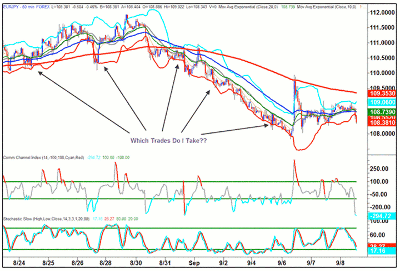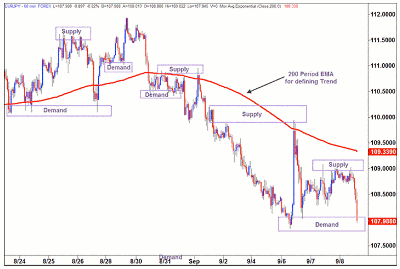Too many indicators can cloud the charts, give unclear signals, and stand in the way of trading consistency, says Sam Evans of Online Trading Academy. To build a clear and consistent trading strategy, focus mainly on supply and demand.
In my seven years of being involved in the world of trading, I have never met a fellow market speculator who has at some point in their trading journey not gone looking for the perfect set of technical tools or indicators. I honestly think this endeavor is a required rite of passage for anyone who hopes to become a consistently profitable trader in today's financial markets, as we are often misled in the early stages of our trading education into believing that there is some magic formula or system which only a select few traders around the world are privy to.
Also, when you combine this "smoke-and-mirrors" attitude with the simple fact that most market speculators are constantly damaged by their lack of emotional discipline, it really is no wonder why the vast majority of novice traders around the world endure disappointing results time and time again and continually search the Internet for the ultimate answer to their questions.
Just like every other trader out there, I too have been down this path, and it is not an enjoyable one to walk, in my opinion. Looking back, I made some huge mistakes in the early stages of my career, even after taking courses from professionals and getting myself the very best education I could.
Was this the fault of my teacher, or because the lessons were not good enough? I guess that at first, there was a small part of me that believed this was the case. I was so focused on making lots of money in the shortest possible time that I was blinded by the reality that I had been taught everything I needed to know, but I was simply failing to use these tools in the correct way.
After sitting back and analyzing my trades and performance from a completely objective point of view, I noticed a damaging pattern in my trading: lack of consistency.
I was taught that the most fundamental aspects of technical analysis revolved around three key areas: support (demand), resistance (supply) and trend. Now, while I know this to be true all these years later, at the time, I questioned what I was being told. In my head, trading had to be more complicated than that! How could just these three simple tools be the source of my future success in trading?
I just had to believe there was more, and I thought my questions had been answered when I was later introduced to technical indicators. I learned all about moving averages, Relative Strength Index (RSI), Bollinger bands, Stochastics and linear regression, plus a whole heap more, and finally I started to see where I thought the secret was hidden.
After applying a whole selection of these indicators to my charts, I sat back and admired my new chart, feeling satisfied that I was finally beginning to develop charts like a pro. It looked a little like this:
The funny thing was that while my charts may have looked impressive and useful, they were in fact highly confusing and told me very little about what was actually going on with price itself.
NEXT: See Why Cleaner Charts Tell a Better Story
|pagebreak|My selection of indicators were there-or so I thought-to help me find my entry signals to take trades. However, I found myself taking random entries from various signals over and over again, while ultimately following no detailed plan whatsoever. You see, the more information you have on a chart, the more potential trades you have to take, be they low-risk, high-reward opportunities or not.
Also, with so many mixed signals on the screen, it then becomes tempting to take each and every indicator signal that comes along, resulting in absolutely no consistency whatsoever.
I found that I needed to strip back my charts and understand exactly what I was trying to achieve in my trading. All I wanted to develop was a clear and simple technique to enter the market which offered me no stress, objective rules, and a healthy risk/reward ratio.
By waiting for every single indicator on my screen to line up before I could take a trade, I was running the risk of missing out on opportunities altogether, as well as confusing myself and diverting my attention from the most obvious and objective trades available.
Let's take a look at a much clearer picture to find our trades, one based simply on support (demand), resistance (supply), and trend.
This time around I have simply placed a 200-period exponential moving average (EMA) on the chart to define my trend. Then I have marked off my supply and demand levels which offer me decent reward-to-risk ratios of at least 3:1 or greater.
If a level is hit in a downtrend (200 EMA sloping down), I will expect bigger moves from supply levels and smaller from the demand zones. If a level is triggered in an upwards trend (200 EMA sloping up), I will expect bigger moves from demand areas and lesser moves from supply.
With the rules defined for my entries and criteria for targets, all that is left to do is to define my risk and trade management criteria. This is a lot simpler than having six different indicators on the chart, isn't it? In fact, it is remarkable how much more we can see on a price chart when we actually have less on it.
So, what is the "perfect" strategy after all?
Well, to answer this question, I would say that it comes down to the individual trader and their own ability to process information and make a decision. I like to be able to look at a chart and know exactly where I will be entering a trade, where I will place my stops, and where my eventual profit target will be.
All I need is an objective reason to enter the market (support or resistance), a preferred direction for the trade (trend), and my plan for profit taking and management of the position. The rest is simply in the hands of the market.
Once you have these steps in place and the picture becomes clearer as to why you are taking a trade, you are well on the way to consistency and building your own "perfect" strategy.
By Sam Evans, Instructor, Online Trading Academy




















